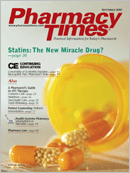Publication
Article
Pharmacy Times
Safety Cannot Be Sacrificed for Speed
Author(s):
Problem
Typically, pharmacies have developedwell-established methods formonitoring the accuracy of the dispensingprocess. Today, however, pharmacywork is increasingly stressful,and these checks and balances can easilybe strained beyond capacity. Withan increasing number of prescriptionsand a shortage of qualified pharmacists,the situation is ripe for potentiallyunsafe working conditions—longhours without breaks; multitasking,including answering phones, overseeingother pharmacy staff, dispensingprescriptions, and counseling patients;and ever-increasing time spent attendingto insurance issues. Inevitably,these conditions can increase thechance for dispensing errors.
One pharmacy's staff knows all toowell about this problem, because a 5-year-old boy died as a result of anorder-entry and medication-compoundingerror that was not caught bythe usual verification process. In thiscase, imipramine was dispensed in aconcentration 5 times greater than prescribed.Imipramine is a tricyclic antidepressantused to treat adults, but italso is used to treat childhood enuresis.
An extemporaneous solution was tobe prepared at this pharmacy that specializedin compounded prescriptions,since a liquid formulation is not commerciallyavailable. A pharmacy technicianincorrectly entered the concentrationof the prescribed solution into thecomputer as 50 mg/mL instead of 50mg/5 mL, along with the prescribeddirections to give 2 teaspoonfuls at bedtime.He then proceeded to prepare thesolution, using the incorrect concentrationon the label rather than the concentrationindicated on the prescription.When the compound was completed,the technician placed it in a holdingarea to await a pharmacist's verification.At this time, 1 of the 2 pharmacists onduty was at lunch, and the high workloadof the pharmacy made it difficultfor the other pharmacist to check theprescription right away.
When the child's mother returnedto pick up the prescription, the cashregister clerk retrieved the prescriptionfrom the holding area without tellinga pharmacist and gave it to the mother,unaware that it had not yet beenchecked. At bedtime, the motheradministered 2 teaspoonfuls of thesolution (500 mg instead of theintended 100 mg) to the child. Whenshe went to wake him the next morning,the child was dead. An autopsyconfirmed imipramine poisoning.
Many factors contributed to thiserror, including inaccurate order entryand issues related to high workload. Acritical breakdown in safety processesoccurred, however, when the cash registerclerk took the prescription from thepharmacy holding area (to prevent themother from waiting any longer for theprescription), thereby circumventing theusual pharmacist verification process.
Whereas this error underscores agrowing problem in health care, theproblem was clearly evident to thispharmacy owner—even a year beforethe error occurred. When interviewedfor an article that appeared in anational publication, he vented hisfrustrations about the scant attentionpaid in this society to pharmacistworkload difficulties in today's healthcare environment. On the day of theinterview, 49 prescriptions were in theprocess of being prepared, and about adozen patients were standing in lineor milling about the store waiting forprescriptions. Yet, this was a slow day.The owner also said that, althoughmanaged care had reduced profits considerablyover the past several years,prescription volume had increased by50%. (At the time of the error, thepharmacy was dispensing about10,000 prescriptions per month versus7000 per month during the prior year,without an increase in staffing.) Medication regimens and drug interactionsalso had become more complex.
To overcome these barriers, theowner added private consultation areasfor patient counseling; installed a$175,000 robot that accurately dispensesthe 200 most common drugs;and diversified sales to offset full-timepharmacists' salaries. These efforts,however, could not have preventedthis tragic fatal error that circumventedthe normal safety processes.
Safe Practice Recommendations
The environment and demandsplaced on health professionals significantlyaffect their ability to provide safehealth care services. Although technologysuch as robots can help, over-stressedprofessionals cannot consistently performat the maximum level of safety.Therefore, it is important that the publicand health care leadership understandthis problem and be more open to tradeoffs—such as a pharmacist working with1 patient at a time and incurring longerturnaround times—which are necessaryto enhance patient safety.
With a shortage of qualified professionals,we as pharmacists need todemand more rapid adoption of computerizedprescribing to reduce timespent with prescription transcription.We should identify the biggest distractionsthat occur in our workplaces andstrive to eliminate or reduce thesources by batching common tasksthat cause interruptions and reorganizingwork areas. Staff members need tobe properly trained to understand safetyprocedures that are in place and toknow the limits of their specific duties.Fail-safe processes to ensure an independentdouble-check before dispensingmedications and performing othercritical processes are a must.
The pharmacy where this particularerror occurred now requires 2 pharmaciststo check every prescription.Unfortunately, this level of vigilancetypically is implemented only after apatient has been harmed from an error.In other pharmacies, especially whereonly 1 pharmacist is on duty, techniciansmay be involved in the double-checkprocess.
A few other strategies can be used toprevent similar errors:
- Have one person perform orderentry, and have a different personprepare the prescription, if possible,to add an independent validationof the order-entry process
- Do not prepare prescriptions usingonly the computer-generated label,because the order entry mayhave been incorrect
- Ensure that the original prescription,the computer-generatedlabel, the prepared product, andthe manufacturer's product(s)remain together throughout thepreparation process
- Verify dispensing accuracy bycomparing the original prescriptionwith the labeled patient productand the manufacturer's product(s) used.
Dr. Kelly is the editor of ISMP MedicationSafety Alert! Community/AmbulatoryCare Edition.
Report MedicationErrors
The reports described here were receivedthrough the USP Medication Errors ReportingProgram, which is presented in cooperationwith the Institute for Safe Medication Practices(ISMP). ISMP is a nonprofit organizationwhose mission is to understand the causes ofmedication errors and to provide time-criticalerror-reduction strategies to the health carecommunity, policy makers, and the public.Throughout this series, the underlying systemcauses of medication errors will be presentedto help readers identify system changes thatcan strengthen the safety of their operation.If you have encountered medicationerrors and would like to report them, youmay call ISMP at 800-324-5723 (800-FAILSAFE) or USP at 800-233-7767 (800-23-ERROR). ISMP's Web address is www.ismp.org.
Subscribe toNewsletter
Pharmacy Times and the Institute forSafe Medication Practices (ISMP) would liketo make community pharmacy practitionersaware of a publication that is available.
The ISMP Medication Safety Alert! Community/Ambulatory Care Edition is a monthlycompilation of medication-related incidents,error-prevention recommendations,news, and editorial content designed toinform and alert community pharmacypractitioners to potentially hazardous situationsthat may affect patient safety. Individualsubscription prices are $45 per yearfor 12 monthly issues. Discounts are availablefor organizations with multiple pharmacysites. This newsletter is deliveredelectronically. For more information, contactISMP at 215-947-7797, or send ane-mail message to community@ismp.org.







